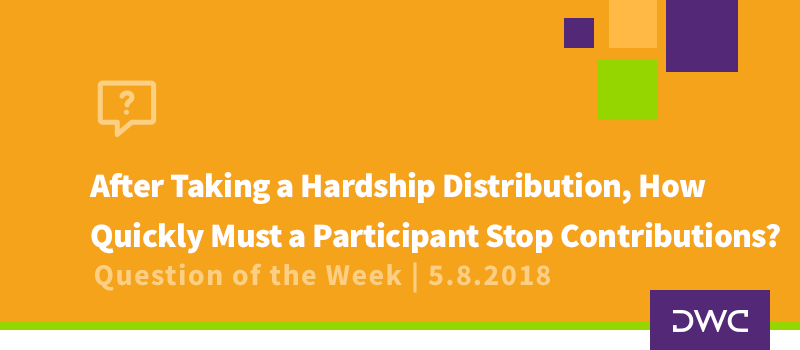
Self-Correction of Late Deposits…Finally, But Not Really
In a case of “be careful what you wish for”, we give you Exhibit A – the new DOL Voluntary Fiduciary Correction Program (VFCP). The new version, published by the DOL today, makes a number of important changes, but this post focuses on updates to the methodology for correcting late deposits of employee deferrals (and participant loan payments).
As a very quick refresher, plan sponsors are required to deposit employee deferrals as soon as they can reasonably be segregated from the general assets of the company. For plans with fewer than 100 eligible participants, seven business days following pay day is deemed to meet that standard. For larger plans, it’s based on facts and circumstances but is generally around 3 business days. Once a deposit is late, correction must be calculated from, generally, the earliest number of days the company has ever made a deposit. We get more into those details here.
VFCP, which is the formal program that provides for voluntary correction in lieu of more severe penalties, was first established in 2002 and was last updated 19 years ago in 2006. In the interim, the industry has been asking the Department of Labor to allow the self-correction of late deposits. The DOL, in response, has pointed to a section of the law they believe prevents them from allowing self-correction without some sort of filing.
Today (January 14, 2025), that all changes…except that it doesn’t. The underlying methodology of calculating the correction itself is the same.
- Determine the earliest date the deposit could have occurred. This is referred to the” loss date”.
- Calculate and contribute lost earnings from that date through the actual date of deposit.
- File Form 5330 to pay the associated excise tax.
- Submit and application along with documentation of the correction to the DOL for approval.
Item #4 is what all the fuss is about, except that the submission hasn’t been eliminated. It’s been changed (actually added to since the existing option is still available). This table summarizes the key differences.
|
Old School Paper Submission |
New and Improved “Self Correction” |
|
| Loss Date | Earliest date the deposit could have been made (often around 3 business days following each pay day) | Pay day |
| Calculation of Lost Earnings | Online calculator or otherwise using IRS underpayment rate | Online calculator |
| Lost Earnings Limit | None | $1,000 |
| Deposit Date Limit | None | 180 calendar days following each pay day |
| Submission to DOL | Application Requesting Approval | Notice of “Self-Correction” |
| Submission Format | Hard copy or email (depending on regional DOL offices) | DOL web portal |
| Supporting Documentation (to substantiate correction) | Submit with Application | Prepare/Compile and Retain with Plan Files |
| Description of Internal Controls (Including Updates to Prevent Recurrence) | Submit with Application | Prepare/Compile and Retain with Plan Files |
| Penalty of Perjury Statement | Yes | Yes |
| DOL Acknowledgement | No Action Letter that Formally Approves Correction | Automated Email Acknowledgment |
| Limit on Frequency of Use | None | None, but monitored for “excessive” use |
Let’s take a closer look at some of these items.
- Loss Date. Unless we’re talking about a huge amount of late deposits, the extra few days is not likely to amount to much additional cost.
- Calculation of Lost Earnings. Most people already use the online calculator, so not really much of a change here.
- Lost Earnings Limit. The DOL states in the preamble that lost earnings that exceed $1,000 are suggestive of a “need for EBSA to actively evaluate the circumstances surrounding the breach and the timing of the correction…”
- Deposit Date Limit. The above statement applies here as well. DOL goes on to say that they “believe that a failure to identify a delinquency and remit contributions…due to the plan within 180 days indicates a potentially serious problem…”
In terms of the actual submission to DOL, there really isn’t much practical difference in what a sponsor must prepare/compile under either option. The difference is that with the regular application, the plan fiduciary must include all of the supporting items; whereas, the “self correction” option requires retention of all supporting items in the event DOL ever asks for substantiation.
There are a few additional tidbits that are worth mentioning. One is that DOL reiterates several times that the costs of correcting late deposits, including fees, the principal amounts, lost earnings, and excise taxes cannot be paid from plan assets (which includes forfeiture accounts).
Second is that lest any plan fiduciaries not take timely deposits seriously enough (now that it’s allegedly easier to correct) or split up corrections into multiple online submissions to stay below the $1,000 lost earnings cap, DOL says in the preamble that it intends to “monitor participating for frequent use…and that it may communicate with repeat users or open investigations to identify and correct systemic issues leading to repeated failures…”
Last but not least, DOL provides a gentle reminder of the importance of filing amended Forms 5500 to the extent late deposits were not properly reported in a previous year. While that requirement was mentioned in passing in the 2006 iteration of VFCP, this brave new incarnation dispenses with the carrot and goes straight for the stick in saying they will cross-reference the numbers from the online submission with the data on late deposits from Forms 5500.
Even when really trying to have a glass-half-full attitude, it’s difficult to see this change as anything more than “meh”. Sure, there is less to submit and what is there can be done online, but the amount of work that has to be done to get to that point is pretty much the same. All of the same calculations, all of the same documentation, etc.
And for a little bit of comic relief, the Regulatory Impact Analysis at the end of the preamble estimates that it will only take benefits managers 2 hours to learn these changes. Hah! We’re already well-beyond that, and we’ve only just covered the late deposit changes. There’s plenty of other geeky goodness in there, and we’ll cover it in a future post or several.
In the meantime, hit us up if you have any questions or need assistance addressing late deposits.

















